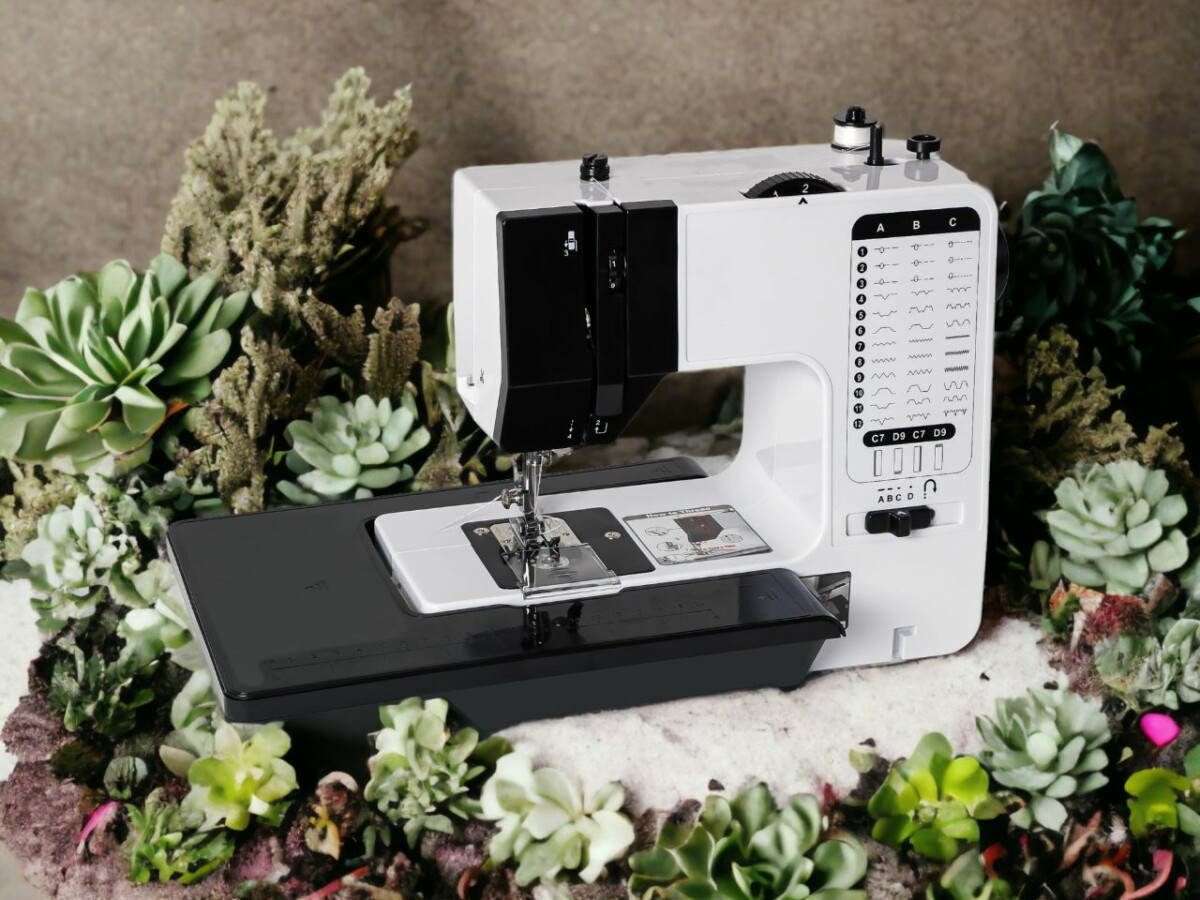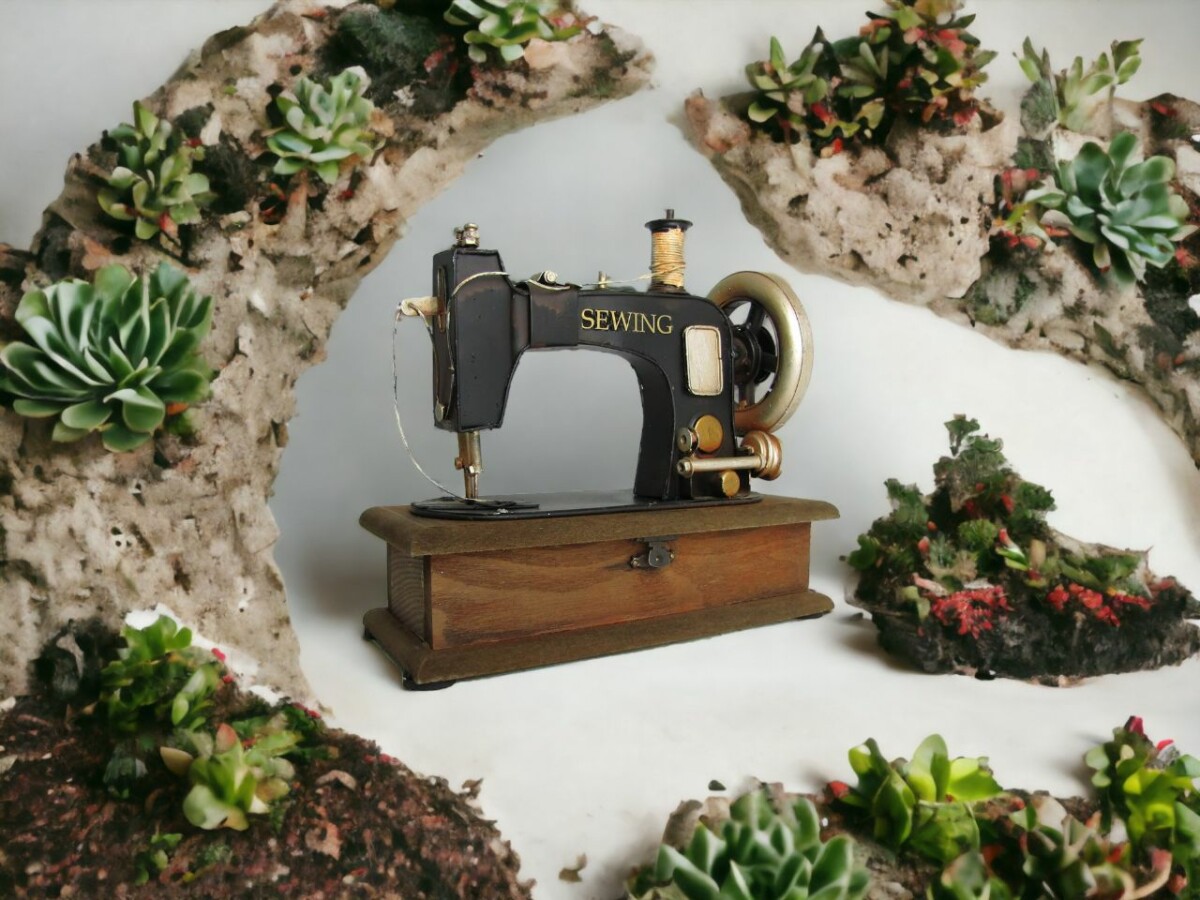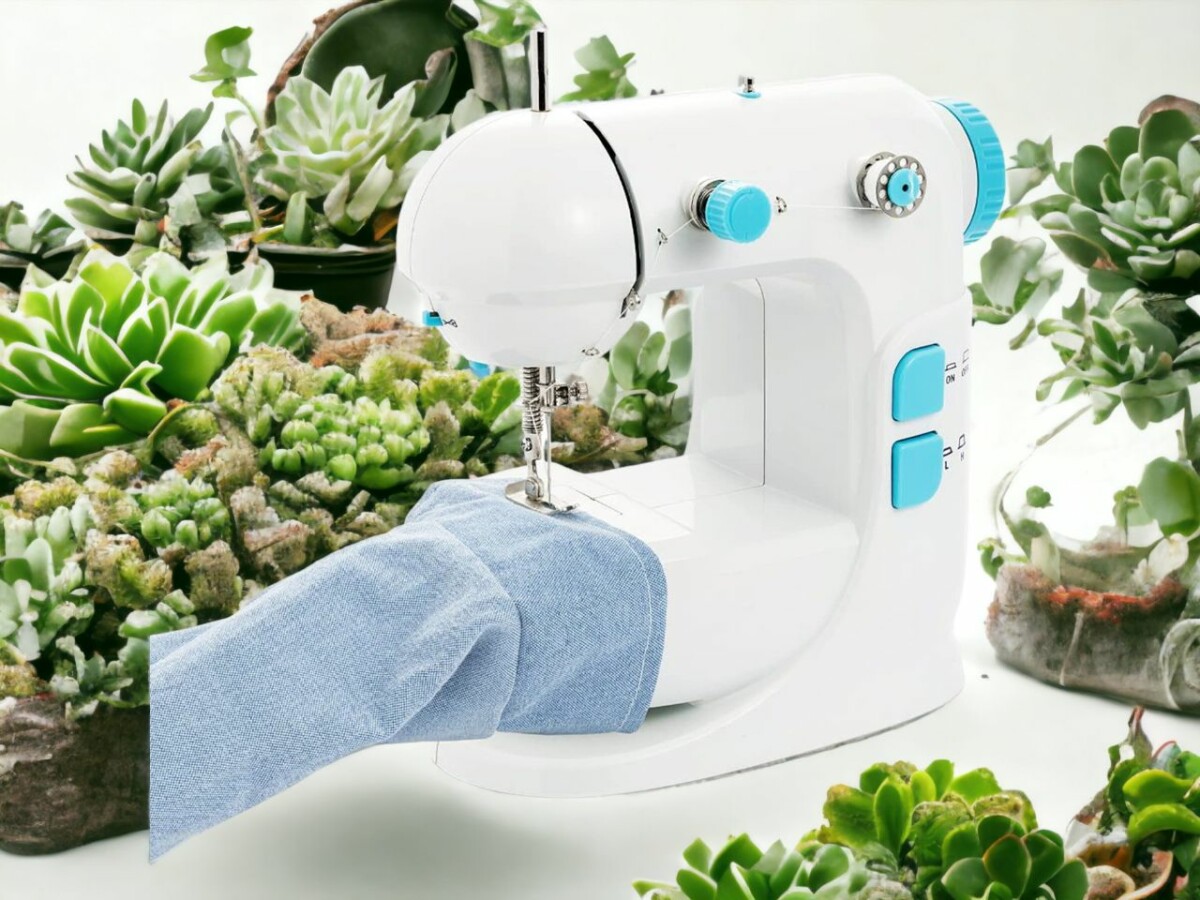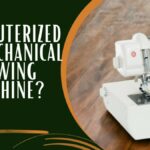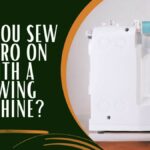So, you’ve just splashed out on a brand new sewing machine – pretty exciting, right?
You’re all set to get crafty and create some real masterpieces.
But, there’s one little hiccup – is it going to fit into your sewing table?
Not every table is a perfect fit for every machine, think of it like finding the right shoes for your feet.
We’re totally on board to guide you through this tricky situation, offering some top-notch advice and handy tips.
So, let’s jump right in and find that perfect match for your new crafting partner.
Can All Sewing Machines Fit in Any Sewing Table?
Sadly, no. Not all sewing machines can fit in every sewing table. When shopping for a table, ensure that it accommodates your machine model, or go for tables with adjustable platforms or inserts.
Before you can make heads or tails of whether any old sewing machine will snugly fit in a sewing table, you’ve got to get down to the nitty-gritty of these two sewing essentials. How portable your machine is, really matters. You’ll cross paths with both nifty, lightweight options and the more hefty, industrial-grade beasts. Just keep in mind, the size and weight of your machine can seriously mess with how well it sits and operates on a sewing table.
Now, let’s gab about tables. Don’t sleep on how your table looks. A well-designed, ergonomic sewing table doesn’t just style up your workspace – it also gives you plenty of room for your machine and all your tools. You’re going to want a table where the dimensions of your machine gel well with the table’s cutout.
Different Sizes of Sewing Machines
Sewing machines, right? They’re like shoes, they come in all shapes and sizes.
From the cute, compact ones that you can pretty much carry around in your bag, to the hulking beasts that look more like a piece of industrial machinery than a tool for crafting.
Knowing the typical size of these bad boys can be a total game-changer, especially when you’re trying to figure out if it’s going to play nice with your sewing table.
But hey, don’t sleep on the oversized machines. They might need a bit more TLC when it comes to setting them up, but they can really up your sewing game.
Standard Sewing Machine Dimensions
Let’s get into the nitty-gritty of sewing machine dimensions, beginning with the standard size. Your average sewing machine for home use comes in at around 15 to 17 inches in width, 7 to 9 inches in depth, and stands about 12 inches tall. However, the big boys in the industry are a totally different story. They’re larger, way more powerful, and built like a tank.
If you’re the type who’s always on the go, portability is a major player. Compact machines come in handy, usually measuring approximately 12 inches wide, 6 inches deep, and 9 inches high. They’re super convenient, but they might cramp your sewing style a bit.
Let’s not forget one crucial aspect: your workspace ergonomics. Having a machine that fits like a glove on your sewing table makes your sewing sessions more efficient, and let’s be honest, way more fun. It’s not just about how big or small the machine is, but also about how well it syncs with your workspace and sewing rhythm.
Oversized Machine Considerations
Alright, so you’ve scored yourself a beast of a machine, and now you’re scratching your head wondering how on earth it’s going to fit into your sewing table. No worries, mate! Let’s tackle this together – machine size and portability, coupled with table adjustability, is the name of the game. Let’s break it down into three key areas:
- Machine Size: Grab your tape measure and get the lowdown on the length, width, and height of your machine. Don’t skimp on this step – you’re going to want to factor in some extra room for any fancy add-ons or accessories you’ve got.
- Table Flexibility: Not every sewing table is a one-size-fits-all deal. Some come with adjustable bits and pieces to accommodate varying machine sizes. Make sure your table is up to the task and can morph to fit your machine.
- Machine Portability: Let’s face it, lugging around a heavy machine is no one’s idea of fun. Think about how often you’ll need to shift your machine and whether it’s a doable task with your current setup.
Types of Sewing Tables: A Comprehensive Overview
Before we get into the nitty-gritty of sewing machines, let’s take a moment to chat about the various types of sewing tables you can find out there in the big, wide world. The material of these tables can be anything from trusty, solid wood to the sleek, lightweight metal. But, hey, it’s not just about what it’s made of, it’s the sewing ergonomics that really matter. You’ll want to keep an eye out for tables that boast adjustable heights and tilt angles to save you from back and neck strain – trust me, your body will thank you later.
And let’s not forget about storage. You’re going to be working with a lot of materials and machines, and having a spot for everything can be a game changer. Foldable tables are a great pick if you’re tight on space or always on the go. But if you’ve got room to spare and big projects on your mind, cabinet-style tables could be just what you need. They offer a larger work surface which can be a real blessing.
Just remember, the table you settle on needs to be a good fit for your sewing needs and workspace. Pick wisely!
Matching Your Sewing Machine to Your Sewing Table: Key Factors to Consider
Alright, so you’re trying to pair up your sewing machine with your table, right? It’s not as simple as it sounds. Here are a few critical things you’ll need to keep in mind to make sure they vibe together.
First up, we’ve got your Machine’s Mobility: Think about the size and weight of your machine. Is it a tiny, featherweight thing that can be carted around easily, or is it a hefty beast that needs to stay put? Smaller and lighter machines give you more freedom when it comes to table options.
Next, there’s Table Adjustability: Your table should be as adaptable as a yoga instructor. It needs to have adjustable height and angle settings so you can tailor it to your comfort. This is key, regardless of how tall you’re or what machine you’re using.
Lastly, you need to think about Machine and Table Compatibility: This is all about the measurements of your machine and how snugly it fits into the table’s cutout or platform.
Tips for Choosing the Right Sewing Table for Your Machine
Picking out the perfect sewing table for your machine isn’t exactly a walk in the park. You gotta weigh in on a bunch of things like the size of the table and whether your machine will fit, how sturdy the table is, and what kind of extra space it offers for your threads and needles.
This ain’t just about finding a table that looks good, it’s about finding one that’s gonna be your sewing buddy for the long haul.
Table Size and Machine
Searching for the perfect sewing table to house your machine? You’ve got to think about a couple of things – size matters, both for your table and your machine. The table needs to be able to comfortably fit your machine, but not be such a beast that moving it becomes a workout.
Let’s not forget about looks – your table needs to be functional, sure, but it also needs to vibe with your workspace. Who wants a clunky, out-of-place table ruining their aesthetic, right? Here’s a quick rundown to help you out:
- Whip out that measuring tape and get the dimensions of your machine. This way, you’re sure to find a table that fits just right.
- Think about how often you’re going to be shifting your machine. If it’s going to be pretty often, save yourself the hassle and get a table with wheels.
- Finally, pick a table that goes with your room’s style. It’ll give your workspace a seamless, put-together look.
Keep these things in mind and you’ll score a table that’s not just practical, but also easy on the eyes.
Construction and Durability
Ever thought about how well-built and long-lasting your sewing table is when you’re shelling out your hard-earned cash? Trust me, it’s something you gotta keep in mind. You need a rock-solid table that can take the weight and shake of your machine – no one wants their table collapsing mid-sew, right?
Generally, your safest bet is going for those made out of hardwood or metal – they’re usually built to last. And remember, it’s not just about buying the table, it’s about the upkeep too. A good quality table should be a piece of cake to clean and look after, meaning it’ll keep looking fresh for years to come.
You’ll thank yourself for picking a table with a smooth, scratch-proof surface – no more worrying about snagging your precious fabric. And let’s not forget about how portable your machine is. Constantly lugging it around? You’ll need something lightweight but sturdy.
Don’t underestimate the power of the right sewing table – it can take your sewing game to a whole new level!
Additional Storage Features
Sure, you’ve got to have somewhere to stash your main stuff, but don’t sleep on the importance of extra storage nooks and crannies. As you’re on the hunt for the best way to squirrel away your supplies, don’t forget about accessories.
- Pegboards: These bad boys are ace for hanging things like scissors and seam rippers. They keep everything in your line of sight and at your fingertips, so you’re not wasting time hunting for that elusive seam ripper.
- Drawers: These are your go-to for keeping threads, fabrics, and patterns out of sight but not out of mind. Try to nab a table with drawers of different sizes, so you can easily store whatever you need.
- Cubbies: These are your best bet for bigger stuff like books, fabric bolts, or sewing machine covers.
Case Studies: Successes and Failures in Pairing Sewing Machines With Tables
Believe it or not, some pairings of sewing machines with tables are a total bust, while others totally rock. The key players here are table mobility and machine compatibility.
Let me paint you a picture: one experiment had this beast of a sewing machine – super heavy-duty – shackled to a lightweight, easy-to-move table. You can guess how that ended. The machine’s heft made the table wobble like a drunk at a nightclub, so good luck with getting those stitches straight.
On the flip side, a compact sewing machine teamed up with a sturdy table was a total win. The machine’s petite frame made sure there was enough workspace and the table was steady as a rock, helping to keep those stitches on point.
Here’s the takeaway: don’t just see if your machine fits on the table. Think about how mobile the table is, your machine’s specs, and what you need for your sewing projects. A solid match needs a bit of brainpower, and maybe even some good old-fashioned trial and error.
Got More Queries about Sewing Machines? We Got You Covered!
Alright, so we’ve got the lowdown on whether any sewing machine can fit in a sewing table, but guess what? There’s a whole lot more to unravel in the universe of sewing machines. You might have found yourself wondering, “Can I use coconut oil on my sewing machine?” Sounds like a bizarre question, right? But trust me, it’s not as wacky as you might think. You’d be surprised how many sewing aficionados out there have leveraged the wonders of this tropical oil to keep their machines running smoothly.
On another note, maybe you’re cooking up some ambitious project that you reckon might need a little more firepower than your humble domestic sewing machine can offer. Ever found yourself pondering, “Do I need an industrial sewing machine?” Yeah, we’ve all been there. It can be hard to figure out when it’s time to step up your game and go for the big guns of the sewing machine world. Luckily, we’ve got just the guide to help you navigate this decision.
Finally, what’s the deal with threads? Do all machines come pre-packaged with a thread supply to get you started? Or is this something we should all be rushing out to buy? Check out our insights on the question, “Do sewing machines come with thread?”, to save yourself some time, and potentially, some moolah! As they say, every little helps, right?
There you have it, folks. We hope that we’ve enlightened you on the whole sewing machine fitting conundrum, and given you a few extra nuggets of knowledge to boot. So, oil up those machines, get ready to stitch your way to glory and always remember – keep calm and sew on!
I have been in the embroidery field for over 10 years. My career first started when I was an apprentice to a local seamstress where I started to learn the basics of garment construction and alterations. That’s where I started to love sewing and began to hone my skills even more.


